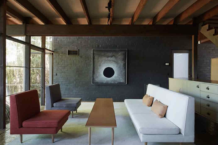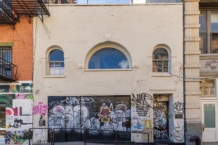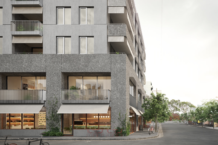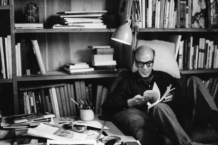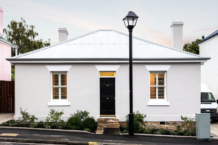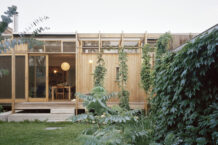Open Conversation: Henry Wilson with Bo Reudler
Architecture, Open Musings - by Matthew
Sydney based designer Henry Wilson talks with Dutch designer Bo Reudler about running an independent design practice.
Henry Wilson: How have you found the process of designing, building and selling your own designs? Is this a common direction for emerging designers from your network?
Bo Reudler: In the Netherlands it’s quite common for young product designers to be self-producing. This is partly due to the previously generous subsidy policy. This is all changing now. But it’s not only the subsidies. It’s also an attitude. It’s difficult (and doesn’t get any easier now) to get picked up by the big design labels and I think the Dutch are a bit more comfortable to say: if you’re not interested in my work, then I will just produce it myself. My partner who is Australian thinks this attitude has to do with our culture of cycling: you can get anywhere you need to with your own two legs (having a flat country helps here too).
It has not been an easy process so far. In design school we were taught to design well but not to be good designers. I didn’t know anything about the commercial side of design when I graduated. I had to learn it the hard way. But I’m very happy though that I took this path. Now I know what’s involved in every part of the design process, and even if in the future, I might not be producing or selling my own work anymore, I can still keep a good overview of what’s involved.
Henry: I had heard rumours that the Dutch government would be changing the access to funding for emerging artists and designers. Do you think this will change the design environment in The Netherlands? Has it already?
Bo: Yes, this change has already begun. Subsidies have dried up and designers are looking for other sources of finance. Most of all, designers must now take a more commercial standpoint. Recently, the focus has been on subsidies for internationalization instead of purely for artistic purposes. And at this year’s Dutch Design Week, several crowd-funding initiatives were launched.
Subsidies were without a doubt part of the success of the previous generation of Dutch designers; instead of having to take the market as the starting point, designers were in the luxury position to take the product as a starting point instead. This placed Dutch design at the forefront of (conceptual) design. On the other hand, most designers in the Netherlands don’t actually receive any subsidies and the cutbacks mean that everyone is on a more even playing field. We all have to find new ways.
So what attracted you to the Netherlands? Why did you choose to do your masters here?
Henry: I discovered the Design Academy Eindhoven at a pivotal point in my life. I was attending Milan Salone soon after graduating and was just so disheartened by some of the things I saw being flung into production with, what seemed like, little consideration beyond a dollar value. The DAE felt like it was offering an alternative at the time, a different look at the typical masters education.
On the subject of dollar value, on your website you have some barter options. Have you done much work for barter? What have been some of the things you have traded for?
Bo: Actually the barter arrangement is a relatively new feature on my website. So new, I haven’t had any offers yet! I felt it would be great for example to trade some of my products for works of colleagues whose work I love, so I decided to create the opportunity for this.
Henry: Do you see yourself ever manufacturing with a company on a royalty basis?
Bo: In the past few years I’ve mainly been working on limited edition pieces and one-offs. I do initiate many of my collections. I think limited edition pieces – much like Haute Couture – are meant to inspire, show new ways, they’re basically for people’s hearts. I enjoy this side of design as much as making products meant for peoples homes, like the Bamboo WIndsor series. In the future I would enjoy the challenge of working on more industrially produced pieces with a design label.
Henry: How do you find events such as Dutch design week for the exposure of your work? It is becoming a larger and larger event on the design calendar.
Bo: I’m surprised every time I exhibit at Dutch Design Week. The event definitely attracts more and more international visitors each year. But what’s special is that the event attracts many regular visitors outside the design industry, who are curious about design.
The 2013 event in October was very successful again. I’m even wondering if it’s really necessary to move the whole Dutch Design circus to Milan each year anymore… What are design events like in Australia? What are the Australian aspects you find inherent in your work?
Henry: In the past few years they have picked up a lot, however I do sometimes think they lack the dynamic layer of emerging design talent that is so exciting in the European shows. Regarding Australian aspects in my work, people are often asking what is an Australia’s design ‘language’. I have yet to figure that out and not sure there is an answer. It’s still very much a developing design nation. Things seem to be changing rapidly and it is exciting to be back here after my time abroad. If feel that Australians relate to a kind of structural honesty or concept. I think that, and a slightly awkward, irregular luxury is something we share with the Dutch.
We are also pretty good at self-production over here, just making do with the resources we have at hand. The Dutch are also pretty good at that… It is an important part of design now days I think.
How have you seen Dutch design changing since the years of Droog, Moooi etc.. Where would you like to see it develop in the future?
Bo: I think Dutch design has matured but is still young at heart. I hope it’s able to maintain a certain independence and edge. I would also like to see environmental concerns to become completely embedded in the design process. We shouldn’t have to talk about sustainable design anymore; this should be inherent to the design process.



